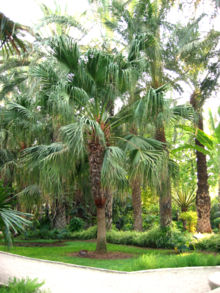Livistona
| Livistona | |
|---|---|
 |
|
| Livistona chinensis | |
| Scientific classification | |
| Kingdom: | Plantae |
| (unranked): | Angiosperms |
| (unranked): | Monocots |
| (unranked): | Commelinids |
| Order: | Arecales |
| Family: | Arecaceae |
| Subfamily: | Coryphoideae |
| Tribe: | Corypheae |
| Subtribe: | Livistoninae |
| Genus: |
Livistona R.Br. |
| Synonyms | |
|
|
Livistona is a genus of palms (family Arecaceae), native to southern and southeastern Asia, Australasia, and the Horn of Africa. They are fan palms, the leaves with an armed petiole terminating in a rounded, costapalmate fan of numerous leaflets.
Livistona is closely related to the genus Saribus, and for a time Saribus was included in Livistona. Recent studies, however, have advocated separating the two groups.
Livistona species are used as food plants by the larvae of some Lepidoptera species including Batrachedra arenosella (recorded on L. subglobosa) and Paysandisia archon.
Kho (L. speciosa) is the tree of Khao Kho District in Thailand.
Robert Brown named the genus Livistona after Patrick Murray (1634–1671), Baron of Livingston, a botanist and horticulturist, who was largely responsible for establishing the botanical gardens in Edinburgh, Scotland.
...
Wikipedia
